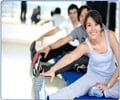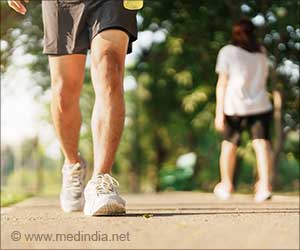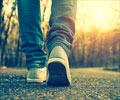Do's and Dont's
Walking as we know is the simplest form of physical activity. But little do we realize that incorrect walking posture and pattern stands to be the biggest cause of pains and aches in the lower limb and back. Again, if we take up walking without giving a thought to appropriate clothing and without realizing the need for regular hydration, we actually land up in trouble sooner or later.
- Wear comfortable shoes and loose clothing. Even better, walking barefoot can strengthen and stretch cramped muscles.
- Dress according to the weather conditions.
- Wear lightweight, properly fitting shoes with good cushioning in the heel to minimize pressure on the foot joints.
Specifications for Walking Shoes:
- Sole of the shoe should be flexible enough to bend and twist the toe area.
- Shoes should be made of mesh fabrics rather then of leather while going for early morning or evening routine walk as such shoes are lighter.
- Avoid cotton socks, wear synthetic socks made of polypropylene instead, as they don't compress, dry quickly, prevent blisters, and pad the heel.
Here are a few do’s and don’ts of walking:
- Be careful of straining the calf muscles as well as the muscles at the front and the back of the thighs. Ten minutes of warm-up exercise and 10 minutes of cool-down exercise helps in maintaining homeostasis in the muscles.
- Try and walk on a flat surface to reduce the strain on legs and feet.
- While walking, keep the body erect, head up, eyes looking straight ahead, and shoulders down, buttocks tucked in and arms at the waist level. Try not to swing the hips from side to side as you walk. Each foot should land under the torso, almost flat and toward the heel – short, heel-toe stride is recommended for walking.
- Drink a glass of water every hour throughout the day to stay hydrated. Ten minutes before your walk, drink a glass of water.
- During your walk drink a cup or more of water every 20 minutes.
- After you finish, drink a glass or two of water.
- Avoid taking caffeinated beverages immediately before going on walk. Caffeine act as diuretics causing loss of fluids, making you feel thirsty.
- For walks extending over 2 hours, replenish your body with electrolyte-replacement sports drink whenever you feel thirsty.
- Initiate your walk with a warm-up and simple stretching.
- Step 1: Warm-Up
Initially walk at a slow pace for 5-10 minutes signals your muscles
- Step 2: Stretch.
Stretching is the key to warm up your muscles and relieve soreness.
- Face the wall at a distance of arm's length. Place your palms flat against the wall slightly below your shoulder height. Keep your back straight and firm your heels on the floor. Now slowly bend your elbows until your forehead touches the wall. Hold this position for 20 seconds and relax. Repeat this exercise 10 times.
- Stand erect with feet apart and arms over head. Try to reach as high as possible while keeping heels on floor and hold this position for 10 seconds and relax.
- Flex your knees slightly and bend your trunk slowly at the waist, trying to touch the floor or actually touching the floor. Hold for 10 seconds and relax. (This exercise is not recommended for patients with back problems or thromboembolism.)
Get your walking shoes on! As Thomas Jefferson, the third President of United States, said, ‘Of all exercises walking is the best’.


















